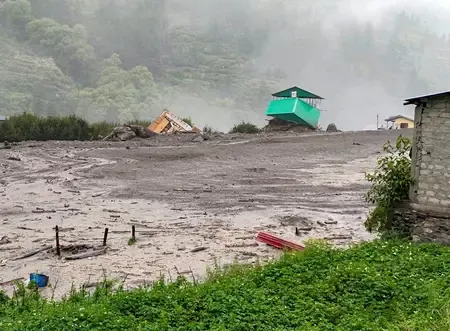Is the IAF Prepared to Aid in Rescue Operations in Harshil After a Cloudburst?

Synopsis
Key Takeaways
- The IAF is on standby to assist in rescue operations.
- Heavy rainfall has hindered air operations.
- Coordination among agencies is crucial for effective response.
- Many families are at risk due to the disaster.
- Timely relief efforts are vital to minimize casualties.
New Delhi, Aug 5 (NationPress) A sudden cloudburst has resulted in extensive mudslides and landslides in Harshil, Uttarakhand, prompting the Indian Air Force (IAF) to be on high alert. They are prepared to support the ongoing rescue efforts led by the Indian Army, Indo-Tibetan Border Police (ITBP), and the National Disaster Response Force (NDRF).
IAF sources have informed IANS that helicopters from three significant airbases—Chandigarh, Sarsawa, and Bareilly—are on standby for aerial rescue and supply operations.
These resources comprise two Chinooks, two Mi-17V5s, two Cheetahs, and one Advanced Light Helicopter (ALH), according to an IAF official who spoke anonymously.
However, challenging weather conditions over the upper regions of Uttarakhand hindered air operations on Tuesday.
“Helicopters were set to depart today, but due to poor visibility and heavy rainfall, it was deemed unsafe to fly,” the official noted.
Once conditions allow, the helicopters will head to the Harshil area to join the extensive relief operation. “Upon deployment, they will aid in evacuating casualties, delivering relief supplies, and supporting ground rescue teams,” added the official. Meanwhile, the Indian Army has already dispatched 150 personnel who arrived at the mudslide-affected area near Dharali village shortly after the disaster.
The NDRF and ITBP teams are actively engaged in search-and-rescue missions amid extremely difficult terrain and relentless rainfall. The situation in Harshil is precarious, with numerous families reported stranded or missing due to flash floods and debris flows.
Communication lines have been disrupted in some areas, and roads have been washed away, making air support crucial once the weather improves.
Rescue agencies are collaborating closely to minimize casualties and provide timely relief to the affected communities.
Ongoing rainfall is the primary obstacle in the response efforts.









